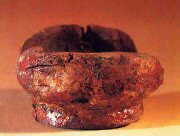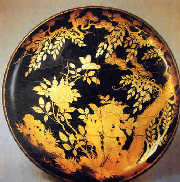 |
| Painted lacquer case, late Warring Period (476-256 BC) |
Lacquerworks in the Warring Period (770-256BC) represented unusually high levels in terms of design and coloring. The painted lacquer mirror case "Panorama of the Journey" unearthed in a tomb in jinmen, Hubei, vividly showcases the life of its owner, known as a masterpiece of the time.
Chinese lacquer art came into its golden age during the Han Dynasty (206BC-220AD). At that time, the court, nobilities and local merchants regarded lacquer wares as symbols of fortune and status. In order to satisfy personal material needs, they spent numerous human and financial resources to make exquisite lacquer wares. Decoration techniques witnessed new developments in the Han Dynasty (206BC-220AD); inlaid gold and silver pattern appeared on the lacquer wares at that time.
During the ensuing Jin (265-420AD) and Northern and Southern Dynasties (420-589AD), thanks to the introduction and widespread of Buddhism in China, lacquer art began to be applied to Buddha sculptures. One of the important excavations of this time is a lacquer wood screen unearthed in a tomb in Datong, Shanxi Province. The screen, carved with black inscriptions and painted in red lacquer, has lacquer paintings on it, which is based on "Legends of Heroic Women" of the Han Dynasty (206BC-220AD). This lacquerwork is a masterpiece both for its painting and calligraphy.
 |
| Gilded black lacquer plate, Qing Dynasty (1644-1911 ) |
One of the prominent achievements of the Tang Dynasty (618-907AD) is its progress in lacquerwork techniques. For instance, gold and silver pieces are cut into different patterns to be embedded in lacquer roughcasts and polished. Thus exquisite lacquerworks came into being.
Lacquer art was further developed in the following Song Dynasty (960- 1279AD). The flourishing economy and stable society gave rise to varieties of lacquer wares, among which the most distinctive style is single-color lacquerwork. Though deprived of decorative patterns and designs, single-color lacquerwork were made with extremely meticulous craftsmanship.
In the Ming Dynasty, a famous craftsman named Huang Cheng, based on experiences of his own and previous craftsmen, wrote the first book on lacquer art. The book was later annotated by another famous lacquer craftsman, which make it China's only completer theoretic works on lacquer art.

